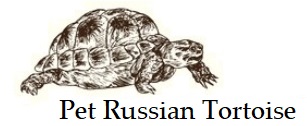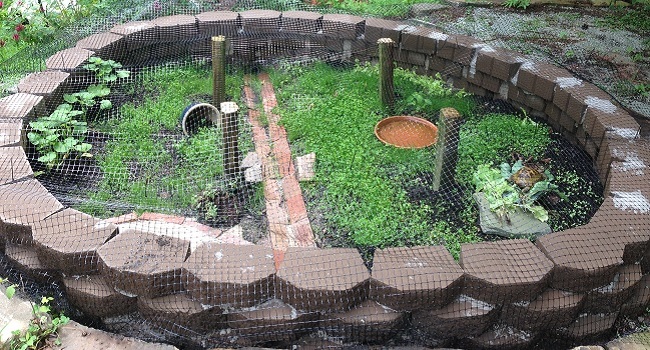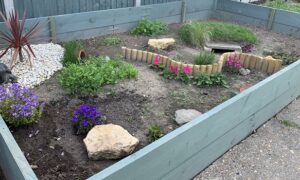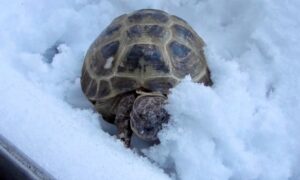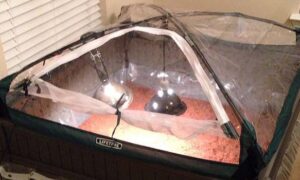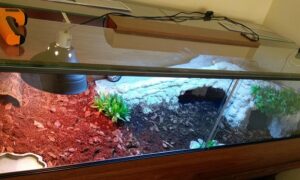Although you can house a Russian tortoise inside year round, it’s important for exercise and natural UV to allow some outside time. To create a safe Russian tortoise outside enclosure, you’ll want to consider where to put the enclosure, what to make it out of and how to landscape it. Whether you’re setting up an outdoor habitat for a baby Russian tortoise or an adult tortoise, you’ll find the overall requirements are quite similar.
How Much Space Does a Russian Tortoise Need?
When designing and planning a Russian tortoise outside enclosure for one tortoise, you want to plan on making the enclosure at least 4-foot by 4-foot. The walls need to be at least 2-foot tall with a 12-inch deep barrier in the ground.
Keep in mind that that more decorations, shelters and plants you put inside the enclosure, the more space you take up.
A general rule of thumb is that the enclosure should be:
- 10 times as long as the Russian tortoise’s length
- 5 times as wide as the Russian tortoise’s width
- 3 times as high as the Russian tortoise’s height
Where to Put a Russian Tortoise Enclosure?
You want to make sure that the habitat is going to have both sunny and shady areas. This will help ensure thermoregulation, where the tortoise can warm up and cool off as needed. Ideally, the enclosure will get sunshine between late-morning and early-afternoon, and the enclosure will be shaded by late afternoon.
If you can’t find the perfect location where you are getting a good amount of shade-time, you’ll need to create a shaded area with plants and shelters.
What Material Can I Use to Build an Outdoor Tortoise Enclosure?
You can use a variety of materials to construct the habitat. Cinder blocks or landscaping bricks are a common choice. You can also use lumber or railroad ties.
When making the underground barrier to prevent your tortoise from digging out of the enclosure, consider burying a cinderblock all the way around. Also take hardware cloth and create an L-shape against the cinderblock. You want the hardware cloth to extend at least 12-inches for the “foot” of the L.
What Do I Need to Put Inside the Outdoor Russian Tortoise Enclosure?
You can make the inside of the habitat as complex and elaborate or as simple and basic as you need as long as you meet basic requirements.
Create Hiding Places and Shelter
It’s important that when designing an outdoor enclosure, you incorporate hides for your tortoise. This will help relieve stress if the tortoise needs a dark place to rest of cool off, as well as a safe place to sleep at night. You can built a shelter with bricks to incorporate with the exterior design of the habitat. You can use cheap flower pots. No matter how you construct the house, make sure that it is sturdy so that it will not fall on your tortoise or blow away. You also want to make sure it’s safe so that the tortoise has a place to go away from potential predators.
Landscaping and Vegetation
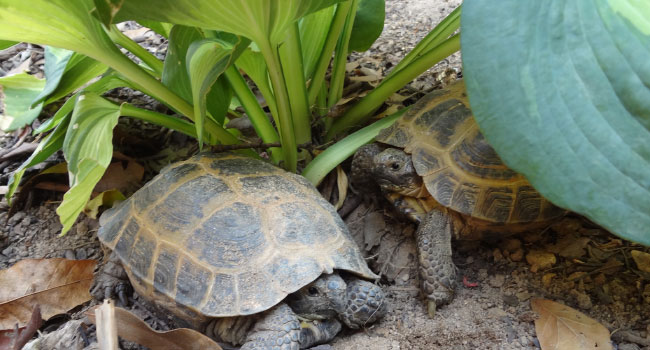
Plants create shade, food, natural hiding places and things to look at. Include edible plants, grasses and flowers.
Popular plants and flowers that are safe for tortoises include:
- English Daisies
- Globe mallow
- Hosta
- Petunias
- Roses
Common and safe grass for ground cover include:
- Bermuda grass
- Bluegrass
- Ryegrass
- Pampas grass
- Orchard grass
Typically, you may not want weeds in your yard, but they’re an important part of a healthy Russian Tortoise diet. Try growing these safe weeds for your tortoise.
- Clover
- Dandelion
- Deadnettle
- Mallow
- Nettle
Water
You can either make a watering area or use a standard water bowl for your tortoise. Depending on the weather, you may want to use a deeper water dish than you may normally use in an indoor enclosure for your tortoise. A slightly deeper watering area will allow your tortoise to soak and cool off during the warmer hours, days or months, depending on your climate.
Make sure to check to ensure your tortoise has water daily. Remove any debris from the water dish and provide fresh water. If you’re using a natural watering hole, do your best to ensure clean water; you may need to consider how to keep the water moving to aerate it.
Safety Precautions Against Predators
Because Russian tortoises are a smaller tortoise, it’s easy for predators to tote away your pet. In order to keep your tortoise safe from predators while in an outside enclosure, you’ll want to take precautions.
When designing an outside enclosure for a Russian tortoise, you’ll want to consider a perimeter fence to keep dogs and coyotes out. You will also want to consider a locking lid that will keep raccoons and birds out.
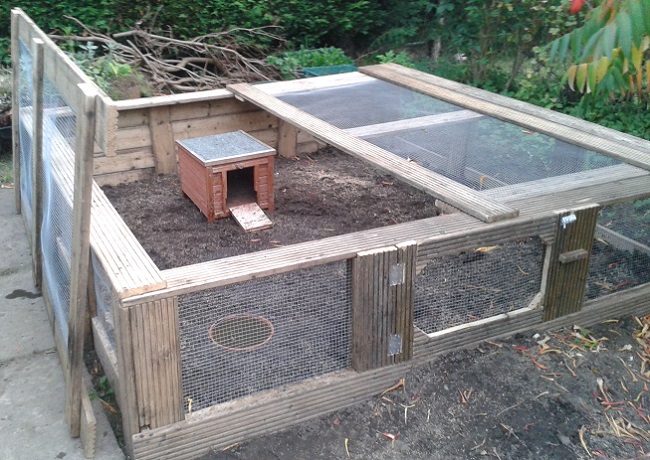
Reduce Stress in the Outside Habitat
The best ways to reduce stress in an outside habitat is to follow basic requirements.
Set up the enclosure with ample space to walk and move around. Don’t over-clutter the area with plants and obstacles.
Offer at least one, preferably multiple houses in the area.
Ensure water is available at all times.
Create a sight barrier so the tortoise cannot see out of the enclosure. If you set up an outdoor habitat with chicken wire and lumber, the tortoise can stress itself out by seeing through the fencing and trying to get to the other side. Make sure the bottom 6-inches or more is a solid wall so that the tortoise cannot see to the other side.
Prevent other animals from getting into the enclosure. Even if you trust your dog (or other pet), it can be stressful for your Russian tortoise to have a dog in and out of the enclosure. Plus, you never know if your other pet may try to bite or attack your small tortoise.
